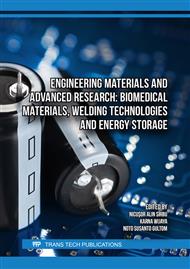[1]
A. Kumar, H.M. Jena, High surface area microporous activated carbons prepared from Fox nut (Euryale ferox) shell by zinc chloride activation, Appl Surf Sci 356 (2015) 753–761.
DOI: 10.1016/j.apsusc.2015.08.074
Google Scholar
[2]
M. Ahmad, A.U. Rajapaksha, J.E. Lim, M. Zhang, N. Bolan, D. Mohan, M. Vithanage, S.S. Lee, Y.S. Ok, Biochar as a sorbent for contaminant management in soil and water: A review, Chemosphere 99 (2014) 19–33.
DOI: 10.1016/j.chemosphere.2013.10.071
Google Scholar
[3]
D. Mohan, A. Sarswat, Y.S. Ok, C.U. Pittman, Organic and inorganic contaminants removal from water with biochar, a renewable, low cost and sustainable adsorbent - A critical review, Bioresour Technol 160 (2014) 191–202.
DOI: 10.1016/j.biortech.2014.01.120
Google Scholar
[4]
M. Kim, H. Lim, X. Xu, M.S.A. Hossain, J. Na, N.N. Awaludin, J. Shah, L.K. Shrestha, K. Ariga, A.K. Nanjundan, D.J. Martin, J.G. Shapter, Y. Yamauchi, Sorghum biomass-derived porous carbon electrodes for capacitive deionization and energy storage, Microporous and Mesoporous Materials 312 (2021).
DOI: 10.1016/j.micromeso.2020.110757
Google Scholar
[5]
J. Hou, J. Hou, Y. Liu, S. Wen, W. Li, R. Liao, L. Wang, Sorghum-Waste-Derived High-Surface Area KOH-Activated Porous Carbon for Highly Efficient Methylene Blue and Pb(II) Removal, ACS Omega 5 (2020) 13548–13556.
DOI: 10.1021/acsomega.9b04452
Google Scholar
[6]
T. Tsoncheva, I. Genova, I. Stoycheva, I. Spassova, R. Ivanova, B. Tsyntsarski, G. Issa, D. Kovacheva, N. Petrov, Activated carbon from waste biomass as catalyst support: formation of active phase in copper and cobalt catalysts for methanol decomposition, Journal of Porous Materials 22 (2015) 1127–1136.
DOI: 10.1007/s10934-015-9988-7
Google Scholar
[7]
H. Behloul, H. Ferkous, N. Bougdah, S. Djellali, M. Alam, C. Djilani, A. Sedik, D. Lerari, B.H. Jeon, Y. Benguerba, New insights on the adsorption of CI-Reactive Red 141 dye using activated carbon prepared from the ZnCl2-treated waste cotton fibers: Statistical physics, DFT, COSMO-RS, and AIM studies, J Mol Liq 364 (2022).
DOI: 10.1016/j.molliq.2022.119956
Google Scholar
[8]
M.O. Esterlita, N. Herlina, PENGARUH PENAMBAHAN AKTIVATOR ZnCl 2 , KOH, DAN H 3 PO 4 DALAM PEMBUATAN KARBON AKTIF DARI PELEPAH AREN (Arenga Pinnata), 2015.
DOI: 10.32734/jtk.v4i1.1460
Google Scholar
[9]
M.N. Ikhsanudin, A.R. Al Ichwan, D.D. Kuncoro, A.S.G. Muthi, A. Jamaluddin, A. Purwanto, Cu-foil modification for anode-free lithium-ion battery from electronic cable waste, Open Engineering 12 (2022) 394–400.
DOI: 10.1515/eng-2022-0041
Google Scholar
[10]
B. Armynah, Atika, Z. Djafar, W.H. Piarah, D. Tahir, Analysis of Chemical and Physical Properties of Biochar from Rice Husk Biomass, in: J Phys Conf Ser, Institute of Physics Publishing, 2018.
DOI: 10.1088/1742-6596/979/1/012038
Google Scholar
[11]
C.F. de Almeida, R.C. de Andrade, G.F. de Oliveira, P.H. Suegama, E.J. de Arruda, J.A. Texeira, C.T. de Carvalho, Study of porosity and surface groups of activated carbons produced from alternative and renewable biomass: Buriti petiole, Orbital 9 (2017) 18–26.
DOI: 10.17807/orbital.v9i1.878
Google Scholar
[12]
S. Mopoung, R. Sitthikhankaew, N. Mingmoon, Preparation of anode material for lithium battery from activated carbon, International Journal of Renewable Energy Development 10 (2021) 91–96.
DOI: 10.14710/ijred.2021.32997
Google Scholar
[13]
K.O. Amoo, T.E. Amoo, O.A. Olafadehan, E.E. Alagbe, A.J. Adesina, M.O. Bamigboye, B.D. Olowookere, K.D. Ajayi, Adsorption of cobalt (II) ions from aqueous solution using cow bone and its derivatives: Kinetics, equilibrium and thermodynamic comparative studies, Results in Engineering 20 (2023).
DOI: 10.1016/j.rineng.2023.101635
Google Scholar
[14]
Y.C. Chang, C.H. Huang, W.R. Liu, Co/ZnO/Nitrogen-Doped Carbon Composite Anode Derived from Metal Organic Frameworks for Lithium Ion Batteries, Polymers (Basel) 14 (2022).
DOI: 10.3390/polym14153085
Google Scholar
[15]
F. Taufany, M.J. Pasaribu, B.Y.S. Romaji, Y. Rahmawati, A. Altway, Susianto, S. Nurkhamidah, J.G. Anfias, Y. Mursidah, D. Fujanita, S. Yulianti, D. Rahmawati, G. Stellarosari, The Synthesis of Activated Carbon from Waste Tyre as Fuel Cell Catalyst Support, Evergreen 9 (2022) 412–420.
DOI: 10.5109/4794166
Google Scholar



